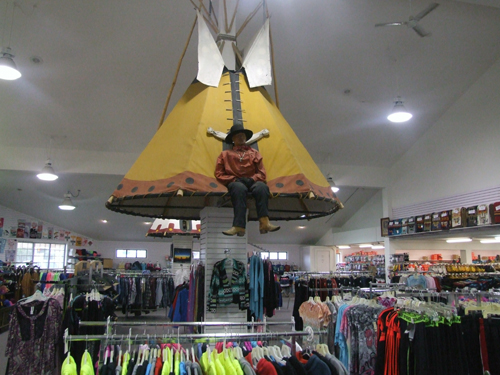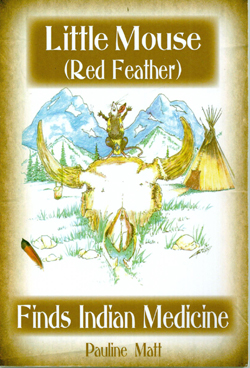
-Sixteenth in a Series–
By Donald H. Harrison

BROWNING, Montana – More than half-way between our previous night’s stop in Lethbridge, Alberta, and our evening’s destination of Kalispell, Montana, grandson Shor and I decided to stretch our legs in Browning, Montana, which is located on the sprawling Blackfeet Indian Reservation.
We browsed the Blackfeet Trading Post at 133 West Central Avenue, finding the sales personnel to be helpful and quite friendly. Shor sorted through glazed stones bearing animal images, and I found myself drawn to Little Mouse (Red Feather) Finds Indian Medicine, a new book by Pauline Matt, a member of the Blackfeet Indian nation.
After reading a few pages, I decided to purchase a copy, surmising that in language intended for audiences ranging from juvenile to adult, Matt’s slim volume would teach me a little about the beneficial customs, “medicine” as they call it, of the Blackfeet people.
I don’t know if my process of learning is an aberration, or if this is what people from other cultures do as well, but in reading about the Blackfeet—as indeed, I had done during our get-acquainted encounter with the Mormon Church in Salt Lake City—I gravitated to the similarities between the ethnic group I wanted to learn about, and those of my own people, the Jews. https://www.sdjewishworld.com/2014/07/26/salt-lake-city-enjoying-familiar-new/
Little Mouse, nicknamed “Red Feather” after one of his prized possessions, is a field mouse, who, in this work of fiction, was befriended by Blue Otter, a Blackfeet Indian girl, and eventually by her tribe. Popular American cartoons like to picture some people jumping up on their chairs and yelling “eek” when they see a mouse, but clearly, one gathers from author Matt, this is 180 degrees from the reaction that a traditionally-minded Blackfeet Indian would have.
In her 80-page book, Matt retells a legend about how the original Chief was chosen. At first, none of the animals, including man, knew who should be in charge. So they had a contest, and, the little mouse, was the winner. But he did not want to be the chief, he simply wanted to eat, raise a family, and live harmoniously with nature. Besides his voice squeaked and he clearly was too small to be a commanding figure. So the mouse told the animals that since he had won the right to be a ruler, he also had won the right to give that honor away. And he chose man to rule their environment in his stead.
Matt’s story teaches that in gratitude, traditional Blackfeet Indians will never knowingly kill a mouse. Nor will they ever pick up a bison skull, because that is a favorite nesting place for mice, and one wouldn’t want to so disturb one’s benefactor.
Now, before any reader dismisses this legend as something very silly—“What, talking animals? Don’t be ridiculous!” I can hear them saying – I’d like to tell you another story.
It seems there was this king who feared a certain people, and wanted the esteemed spiritual leader in the area to put a curse upon them. The spiritual leader hesitated, but finally, astride his donkey, he set off to observe—and perhaps curse—this alien people. As he and his donkey climbed a narrow mountain path, the donkey suddenly stopped and refused to go any farther. The spiritual leader became angry with the donkey and beat her, not once but three times. At that point the donkey looked up at its master, and asked: “What have I done to you that you struck me these three times?” The spiritual leader told the donkey her refusal to go farther had mocked and insulted him. He was so angry that if he had a sword in his hand, he might have even killed her. The donkey then asked: “Am I not your she-donkey that you have ridden all your life until this day? Have I been accustomed to do such a thing to you?”
“No,” admitted the spiritual leader, whose eyes were then uncovered and he saw what the donkey had already seen, an Angel of the Lord blocking the path.
A talking animal? We Jews have our talking donkey in The Torah, our holiest of books. (See Numbers 22:27-30) I don’t remember anyone snickering in synagogue on the Shabbat that we read Parashat Balak.
In Matt’s tale about Little Mouse, whose name in the Blackfeet language was “kyi-na-skina,” we learn that the Blackfeet consider themselves a misunderstood people, with whom the dominant powers have dealt unfairly. Is there a Jew who cannot empathize? And when Grandpa tells Little Mouse that in the world there are those people who choose to find good, and those who choose to find hate, but hating is a “blind, terrible waste,” is there a Jew who can’t say “Amen”?
We also learn from Matt’s fine tale that when the Blackfeet say special prayers, they hold up a holy pipe and offer a pinch of tobacco in gratitude to the Creator, and then to the Sun, the Four Directions, the Animal Spirits, the Moon and Mother Earth.
That sounded a bit to me like the Jewish Festival of Sukkot when we Jews gather four species – the date palm, myrtle, willow and etrog. We bundle them together, and wave them in six directions: up, down, east, south, west and north, in a symbolic plea for rain and for good crops.
In October, Little Mouse learns from Grandfather, the Blackfeet often participate in a spiritual fast while wholly devoting their spirits to their Creator. Do I hear you thinking “Yom Kippur”? Well it’s even more intense than that, in that it last several days “when we can almost see inside of our soul to make our spirit strong with love, compassion and gratitude.”
One gets the feeling that we and the Blackfeet enjoy many ritual similarities, while, of course, also having customs that are unique to one or the other of us.
With the several similarities that I have outlined—a talking animal story, a feeling of having been persecuted, a ceremony offering prayers in many directions, and a fast as winter approaches—it would seem to make it easier for a Jew and a Blackfeet Indian to find their common humanity, and to thereupon build upon it.
I’m glad we stopped, however briefly, in Browning, shortly before taking a two-hour drive through beautiful, eye-pleasing Glacier National Park en route to an evening’s rest in Kalispell. It was, as the Blackfeet say, “good medicine.”
___________________________________________________________________________________________________________
If you go: We stopped several hours after our visit to Browning at the Super 8 at Highway 93 and 1st Avenue East in Kalispell, Montana. It had free wifi and breakfast, and a smoke-free policy.
___________________________________________________________________________________________________________
________________________________________________________________________________________
*
Harrison is editor of San Diego Jewish World. He may be contacted via donald.harrison@sdjewishwpr;d/cp,

Thanks for sharing some of your culture and comparing it with ours in a unbiased way. Its nice to read something positive about the place you call home rather than negative. I shared this article with my good friend/past roommate whom I lived with for a couple of years who is Jewish and also from the San Diego area. We would bring up stuff all the time how we were similar in beliefs and growing up. This article is proof people are similar and why we got along so well.